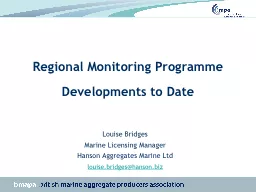

Developments to Date Louise Bridges Marine Licensing Manager Hanson Aggregates Marine Ltd louisebridgeshansonbiz Context Minerals are essential and represent the largest material flow in the GB economy ID: 640913
Download Presentation The PPT/PDF document "Regional Monitoring Programme" is the property of its rightful owner. Permission is granted to download and print the materials on this web site for personal, non-commercial use only, and to display it on your personal computer provided you do not modify the materials and that you retain all copyright notices contained in the materials. By downloading content from our website, you accept the terms of this agreement.
Slide1
Regional Monitoring ProgrammeDevelopments to Date
Louise Bridges
Marine Licensing Manager
Hanson Aggregates Marine Ltd
louise.bridges@hanson.biz
Slide2
Context
Minerals are essential, and
represent the largest material
flow in the GB economySlide3
Construction aggregates represent the largest of these flows:
GB construction aggregates: 225
Mt
pa
(
2015),
of which:
63
Mt secondary/recycled aggregates (29%)
162
Mt primary aggregates (71%)
Equivalent to c.4t per person each yearSlide4
The sector forms the
foundation of the supply
chain for the construction
sector, which represents
c.5% GB economySlide5
GB Construction Aggregate Supply – A Mix
of
Primary
,
Recycled
and
Secondary ResourcesSlide6
Over 900M tonnes dredged since the 1950’s19.47Mt dredged from 37mt permitted (2015)
13.23Mt landed in England/Wales
4.01Mt used for coast defence/fill
2.15Mt landed in
Europe
8% GB primary
aggregates
25% Sand and gravel output in
England
35% Primary aggregate demand in London & SE England (where 1/3rd £144 billion GB construction activity takes place
)
>50% Primary aggregate demand in London
Marine Aggregates by NumbersSlide7
Dredging Locations by RegionSlide8
Why Regional MonitoringA regional approach to monitoring & management has the potential to enable the delivery of more cost effective and consistent compliance data and therefore
support better regulation
Better for operators
Better for regulators
Better for statutory advisors
Regional
working
saves time & effort
saves cost
delivers a consistent
outcome
Similar
benefits to regulators & advisors – best use of
resources
Standard
conditions for all marine mineral licences agreed between MMO, advisors and industry – defines
a model
compliance programme
.Slide9
Standard ‘Model’ Compliance Programme
A new regional monitoring approach aligns all licences on the same baseline requirement
This removes the dislocation of delivery milestones on a licence by licence basis
A regional “stagger” allows for management of delivery
Regional Monitoring – employed to provide impact data and information regarding natural variability in ecosystem
Pre-dredge – all elements
Interim – bathymetry/sidescan & benthic
Post-dredge – all elements
0
1
2
3
4
5
6
7
8
9
10
11
12
13
14
15
16
Licence Specific Monitoring – where required to address isolated sensitivity
Specification as per sensitivity
Year of Dredging
Reviews – includes submission of regional and licence monitoring reviews
Substantive reviews
Interim – bathymetry/sidescan,Slide10
Delivery of Regional Monitoring
Regional survey timelines:
South Coast - 2017
Anglian & Thames - 2018
Humber - 2019
Bristol Channel, North East & North West – tbc
ECR to continue on established
timeline
Establishment of Regional Associations
Each association responsible for implementation, management and delivery of their regional surveySlide11
Current Position - RSMP
Thames Barrier
All available data has been plotted, and through faunal analysis, 12 distinct communities identified which can be found in different areas around the UK, corresponding with sediment types.
A statistical test (
Mahalanobis
Distance) then allows for further analysis of the data to show “pass” or “fail” based on whether the sample has changed from one assemblage type to another.
However it is important to note that a “fail” is just a statistical flag to highlight that further investigation is needed, not an environmental fail
Many reasons for failure, not just a result of dredgingSlide12
Current Position - RSMP
Thames Barrier
The contract for the second RSMP survey on the South Coast has been awarded
Survey planned for Q3 2017
Provision of results by Cefas from the baseline surveys for reporting purposes
Cefas to develop an App to allow contractors to process data themselves (MD test)Slide13
Current Position - RGMP
Thames Barrier
The contract for the baseline geophysical survey on the South Coast has been
awarded
South Coast baseline RGMP survey planned for Q2 & Q3 2017Slide14
Future Plans
Thames Barrier
Keith Cooper to publish peer reviewed
paper
“A big data approach to macrofaunal baseline assessment, monitoring and sustainable management of the seabed”
Development of new good practice guidance by industry and TCE in consultation with MMO and advisors
Demonstrable continued need for guidance to provide baseline positionSlide15
Confidence & certainty in policy, planning and permitting informs long-term investment
Hanson Aggregate Marine Ltd investing in two new ships – due to be in service 2019 (circa €70 million)
Hanson UK investing in pre-cast & concrete plant for supply of major infrastructure projects; e.g. Thames Tideway, Crossrail 2
Future PlansSlide16
Any Questions?